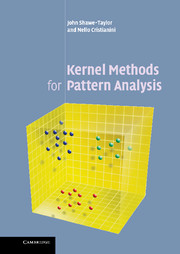Book contents
- Frontmatter
- Contents
- List of code fragments
- Preface
- Part I Basic concepts
- 1 Pattern analysis
- 2 Kernel methods: an overview
- 3 Properties of kernels
- 4 Detecting stable patterns
- Part II Pattern analysis algorithms
- Part III Constructing kernels
- Appendix A Proofs omitted from the main text
- Appendix B Notational conventions
- Appendix C List of pattern analysis methods
- Appendix D List of kernels
- References
- Index
2 - Kernel methods: an overview
from Part I - Basic concepts
Published online by Cambridge University Press: 29 March 2011
- Frontmatter
- Contents
- List of code fragments
- Preface
- Part I Basic concepts
- 1 Pattern analysis
- 2 Kernel methods: an overview
- 3 Properties of kernels
- 4 Detecting stable patterns
- Part II Pattern analysis algorithms
- Part III Constructing kernels
- Appendix A Proofs omitted from the main text
- Appendix B Notational conventions
- Appendix C List of pattern analysis methods
- Appendix D List of kernels
- References
- Index
Summary
In Chapter 1 we gave a general overview to pattern analysis. We identified three properties that we expect of a pattern analysis algorithm: computational efficiency, robustness and statistical stability. Motivated by the observation that recoding the data can increase the ease with which patterns can be identified, we will now outline the kernel methods approach to be adopted in this book. This approach to pattern analysis first embeds the data in a suitable feature space, and then uses algorithms based on linear algebra, geometry and statistics to discover patterns in the embedded data.
The current chapter will elucidate the different components of the approach by working through a simple example task in detail. The aim is to demonstrate all of the key components and hence provide a framework for the material covered in later chapters.
Any kernel methods solution comprises two parts: a module that performs the mapping into the embedding or feature space and a learning algorithm designed to discover linear patterns in that space. There are two main reasons why this approach should work. First of all, detecting linear relations has been the focus of much research in statistics and machine learning for decades, and the resulting algorithms are both well understood and efficient. Secondly, we will see that there is a computational shortcut which makes it possible to represent linear patterns efficiently in high-dimensional spaces to ensure adequate representational power. The shortcut is what we call a kernel function.
- Type
- Chapter
- Information
- Kernel Methods for Pattern Analysis , pp. 25 - 46Publisher: Cambridge University PressPrint publication year: 2004
- 8
- Cited by



